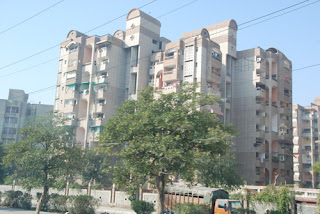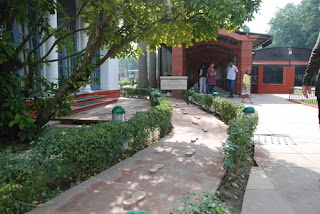New Delhi, India (2/12-13/2013) – New Delhi, India’s
capital city, is a culture shock that assaults most of the human senses. India
is land of contrasts and incredible beauty if you look past the blatant poverty
of a developing-world country.
 |
| Choatic Streets of Old Delhi, India |
The sights, crazy horn honking traffic, vendors calling you
into their shops, overcrowding, extreme contrasts between rich and poor, and
smells can at first lead to sensory overload. Life is lived differently in
India with its huge population of 1.2 billion people. If you approach your
visit to New Delhi with an open mind, you can’t help question what is normal
and come away with a life-changing experience.
 |
| Gypsy Tents on Street - New Delhi, India |
We had a brief visit to New Delhi
and here are our impressions. When driving around the crazy horn-honking polluted traffic
in New Delhi, you would readily conclude that the buildings, roads, and even
main sights suffer from neglect and much of the city looks like a developing
country. Watching cows walk down the main streets of a large city is a bit
strange but its part learning experience available from the culture of India.
 |
| Indian School Girls - New Delhi, India |
In the mist
of all this, the colors of India are marvelous – the women in their colorful
clothing, flowers, richly painted buildings, and even the trucks. Color is everywhere and the food is
wonderful.
Obviously
apparent, India is a young country with a large amount of it population below
the age of 30. Hinduism is the religion of about 90% of New Delhi's population.
There are also large communities of Muslims. With the vast differences in
geography, culture, languages, and ethnicity, India is proud of being the largest
democracy on Earth.
 |
| High Rise Building - New Delhi, India |
 |
| Streets of Old Delhi, India |
There are
vast differences between New Delhi and Old Delhi. Build by the British, New
Delhi, with its wide boulevards, was declared India’s capital in 1911, but Old
Delhi still is the center of commerce and religion. Demonstrating Old Delhi’s
Islamic past and initiating you to your new world, the largest and principal
mosque in India is in the heart of Old Delhi having been built in 1656. It can
hold an amazing 25,000 people. The streets of Old Delhi are narrow and twisted,
and all the streets have snarled clumps of electrical wires.
 |
| Qutub Minar - Old Delhi, India |
Old Delhi’s
Islamic history is shown when visiting several famous sites. As a display of
the Mughal’s splendor, the massive Red Fort is worth visiting (see photo). It is a 17th century fort complex and
palace for the powerful Mughal Emperor Shah Jahan. He moved his capital here
from Agra and it served as the capital of the Mughals until 1857. Also, Qutub
Minar, an UNESCO World
Heritage Site built in 1192, is India’s tallest minaret. While in Old Delhi, a
visit to the Chandni Chowk market
area, located near the Red Fort, is an Indian bargain-finders and
people-watching delight. The ambiance is exciting pandemonium with constant
activity and stores selling a large variety of merchandise.
 |
| Laxminarayan Temple - New Delhi, India |
The
Laxminarayan Temple
(also known as the Birla Mandir) is a Hindu temple.
The temple spread over 7.5 acres, is adorned with many shrines, fountains, and
a large garden (see photo). Located west of Connaught Place, the Laxminarayan Temple is an interesting
introduction to the Hindu religion.
 |
| India Gate - New Delhi, India |
The India
Gate (see photo) is the national monument of India built in 1931
commemorating the 90,000 soldiers of the British Indian Army who lost their
lives in World War I and the Third Anglo-Afghan War. India’s leaders supported
Great Britain in hopes of greater support for their independence that came in
1947.
Some very brief
history about New Delhi... New Delhi was founded in 1911 and now has almost 14 million
population in the metropolitan area. It
is the capital of the India and home of the executive, legislative, and
judiciary branches of the government of India.
 |
| Last Steps of Gandhi - New Delhi, India |
Old Delhi,
originally called Shahjahanabad, was a walled city built by Mughal emperor Shah
Jahan starting in 1638. Old Delhi was the capital of the mighty Mughal Empire
until 1857 when the British moved India’s capital to Calcutta.
 |
| Indian Parliament - New Delhi, India |
Travel tips... India has three main seasons - hot
and humid Summer (March to May), Monsoon (June to September), and Winter
(milder summer). The best time to visit is during the winter between November
and February – February with some of the best weather. Locals in New Delhi can
manage to speak in broken English and those working in hotels, many
restaurants, businesses, and belonging to middle and upper class can speak fluent
English.
 |
| Food Vendor - New Delhi, India |
Staying healthy in India... Most visitors choose bottled water that can be
purchased reasonable cheaply – many hotels supply bottled water. When buying
water from street vendors, make sure the lid is sealed and not refilled with
tap water. Make sure you rinse your toothbrush with bottled water and keep your
mouth closed when showering. It is also wise to be careful what you eat.
Outside of major tourist hotels and restaurants, particularly risky things to
stay away from are raw leafy vegetables and egg-based dressings like
mayonnaise, and minced meat. To be safe, you should stick to boiled, baked, fried,
or peeled goods.
Please see
our other 6 posts about incredible India:
Please
enjoy 250+ wonderful places around the world, with award-winning
photos, from our BLOG ARCHIVE on the right ---->

Travel for half the cost for all levels of travel from budget to luxury and 100's of other unique travel tips! From a former Economic professor, experienced traveler (106
countries), award-winning travel photojournalist/blogger, featured speaker at large travel shows,
host of the travel TV show Plan Your Escape® TV aired on the CW network,
and travel columnist for the Huffington Post, our
popular 5-star customer rated groundbreaking and comprehensive how-to world travel book Plan Your Escape, Secrets of Traveling the World for Less Than the Cost of Living at Home reveals secrets how you can travel and see
more for half the cost for all trips from weekend getaways to longer vacations
and trips, experience more adventure and romance, safely realize your travel
dreams with comprehensive planning tools and checklists, travel the world for
less than $100/day for a couple, and much more!














No comments:
Post a Comment
We love to hear from you!